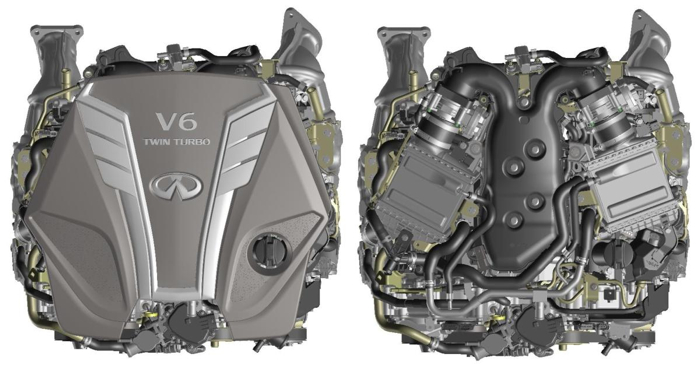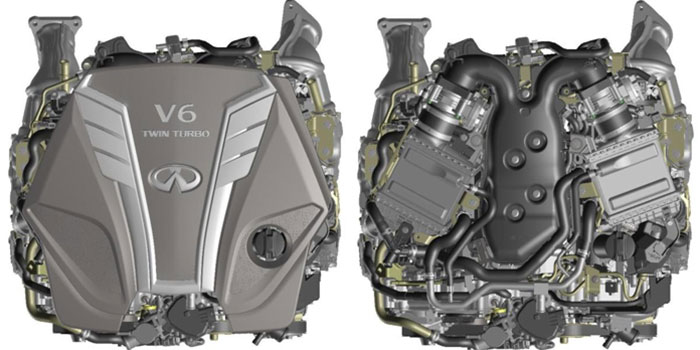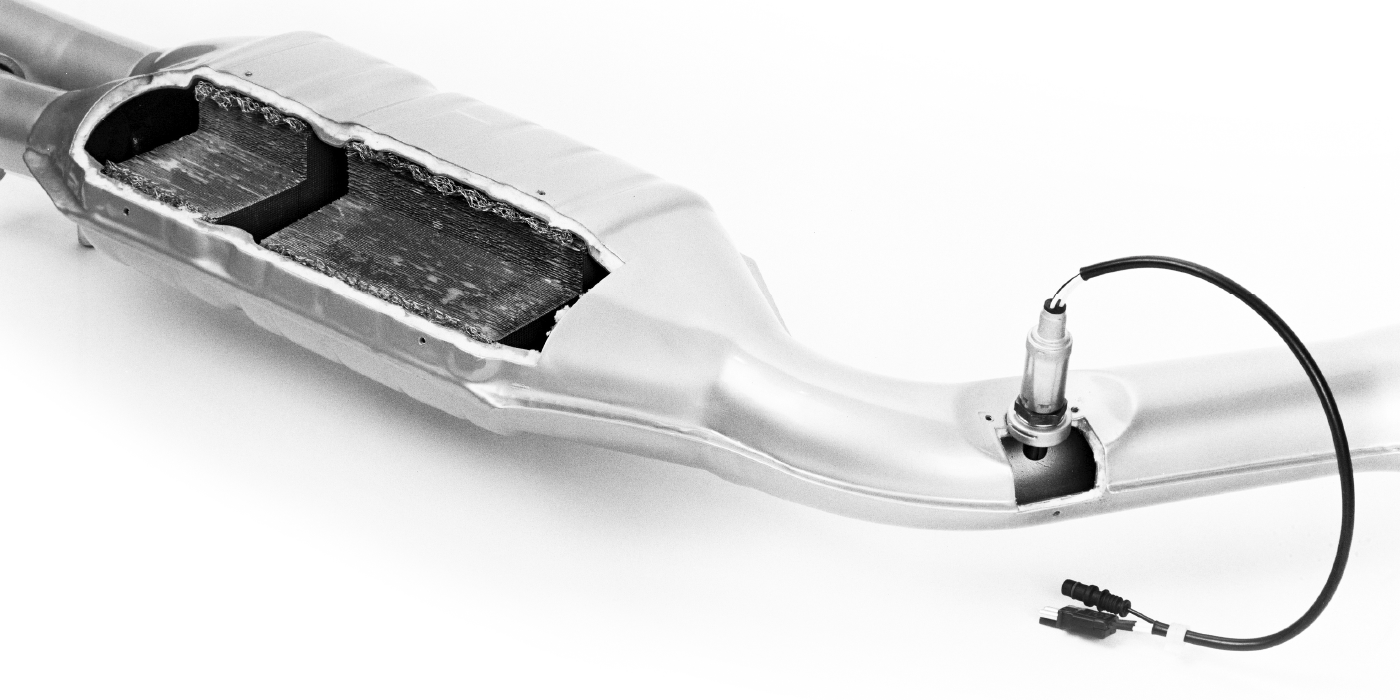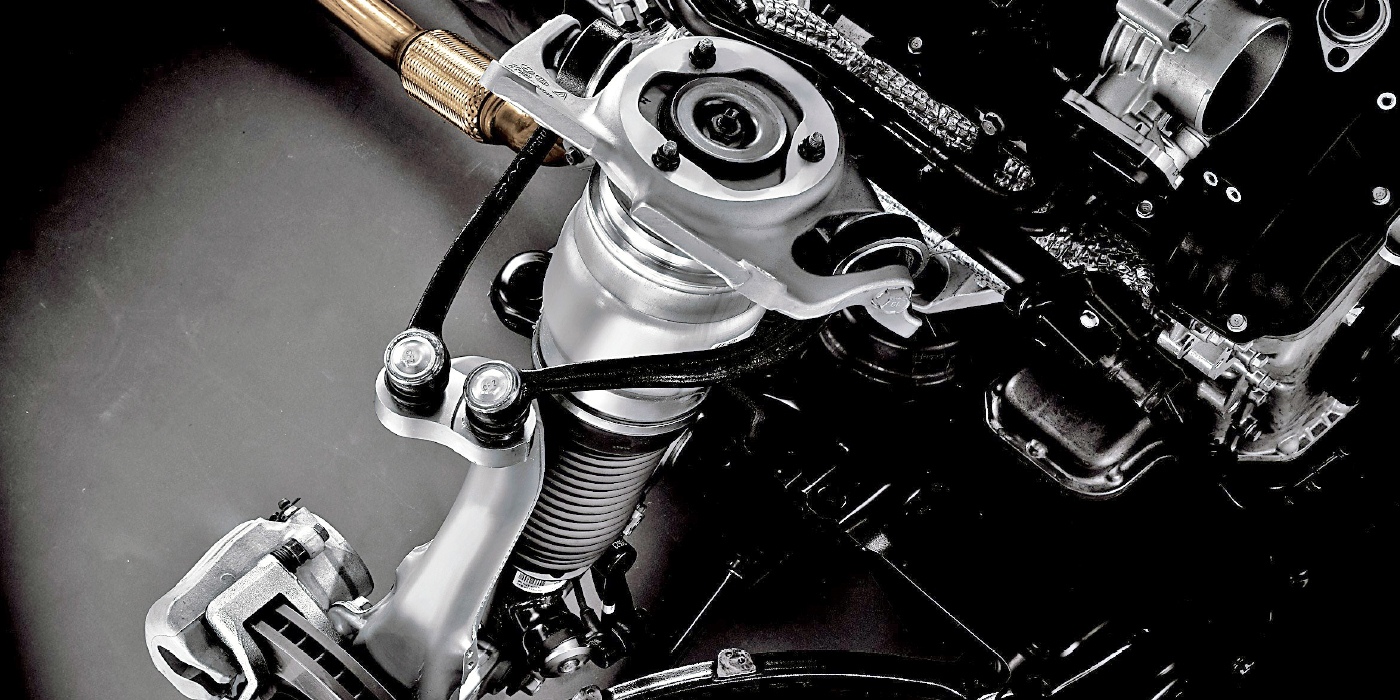 The new compact and lightweight 3.0-liter V6 twin-turbo engine is the most advanced V6 gasoline engine that Infiniti has ever offered, striking an ideal balance between driveability, efficiency and performance.
The new compact and lightweight 3.0-liter V6 twin-turbo engine is the most advanced V6 gasoline engine that Infiniti has ever offered, striking an ideal balance between driveability, efficiency and performance.
The 3.0-liter V6 twin-turbo engine is from the new and exclusive ‘VR’ powertrain family, born out of the brand’s longstanding heritage of V6 powertrain production. The new engine has been engineered to empower the driver and offer increased power and torque and higher levels of efficiency than any comparable predecessors from the company.
The engine’s reduced weight and contained size is credited, in part, to lighter and more compact cylinder blocks. The result is greater mechanical efficiency, while a series of new features and in-house innovations secure superior performance.
Selected Infiniti models will be equipped with the all-new 3.0-liter V6 twin-turbo from 2016 onwards, with the engine available in two performance levels – 300 or 400 horsepower. Both engines share the same technologies and offer the same unrivalled sensation of potent and immediate power delivery.
The 3.0-liter V6 twin-turbo engine has been developed to deliver optimal power and torque for an engine of its size, together with optimized fuel efficiency. The high-output version of the power unit delivers 400 hp at 6400 rpm and 350 lb.-ft. maximum torque at 1600-5200 rpm; while the 300-hp version at 6400 rpm produces 295 lb.-ft. torque at 1600-5200 rpm.
While the 300-hp version is fitted with a single water pump, the 400-hp engine uses two for more effective management of heat when under operating at higher loads. In addition, for the 400hp variant an optical turbo speed sensor gives a 30% power boost to the turbo system by allowing the blades to spin faster.
These outputs have been achieved while ensuring an improvement in fuel efficiency of up to 6.7% and this represents a best-in-class power-to-efficiency ratio for the 400-hp power unit.
This power-to-efficiency performance was made possible thanks to a set of newly-developed features. Advanced timing control ensures improved responsiveness, enabling quicker reactions to driver inputs.
A new electric motor is fitted to the valve timing system, increasing the speed of the throttle for enhanced response times. Not only does this have a positive impact on performance but also efficiency, with the engine able to operate more efficiently through closer control of cylinder combustion.
Power delivery is enhanced through an advanced new twin-turbo system enabling smooth and immediate responses under acceleration, while aiding efficiency. An optimized turbine blade design helps the engine generate greater overall performance, with faster turbine revolution speeds allowing for an immediate response from the twin-turbo system.
In addition, the V6 engine features a new turbine speed sensor, which allows for the twin-turbo system to perform at up to 220,000 rpm – at steady condition and 240,000 rpm at transient condition– higher than ever before for an Infiniti V6 power unit. With greater capacity for faster revolutions, the twin turbochargers boost the higher-powered version of the engine to deliver higher power and torque. The turbo speed sensor on the 400hp version allows for up to 30% more power output.
The engineers have developed a water-cooled intercooler system to further improve performance and efficiency. The system rapidly cools air as it enters the twin-turbo system, reducing turbo lag and allowing for more immediate acceleration. The secondary result is a cooling system, which is more compact – meaning a shorter flow path for air entering the turbocharger to enable quicker engine responses.
A new electronic wastegate actuator allows closer control of exhaust gas flow away from the turbocharger, restricting the amount of exhaust gas flowing through the unit to improve overall engine efficiency.
The core structure of the 3.0-liter V6 twin-turbo engine weighs 429.5 lbs. – 39.1 lbs. less than the engine it replaces. The new turbocharger and advanced intercooler (or CAC) system componentry adds just an extra 56.9 lbs, for 486.3 lbs. in total.
The all-new power unit is 19% smaller in capacity than earlier V6 engines offered by Infiniti. It builds on the company’s legacy of embracing new engineering solutions and technologies. Just as these earlier engines have always been respected for their lightweight aluminum construction and low mechanical friction – making them smooth, durable and highly responsive – the 3.0-liter V6 twin-turbo engine follows its performance-oriented predecessors with a more compact and lightweight design, while maintaining a performance focus.
Chief among the new weight-saving elements is the adoption of spray bore coating for the engine block and integrated exhaust manifold for cylinder heads. Not only does this make the engine lighter, but this also aids cooling as heat can dissipate more effectively through the aluminum alloy bore wall, a process boosted further by its physical design, which encourages faster engine heat management.
The lower weight throughout the engine contributes to greater mechanical efficiency, with lower inertia from its lightweight aluminum components, while this added efficiency adds to the driveability and overall performance of the V6 engine.
The engineers have adopted a series of innovation technologies for application in the new V6 to deliver a more engaging driving experience. Special among these is a new direct-injection gasoline (DIG) fuelling system. The high-pressure DIG system allows for more precise injection of fuel into the combustion chamber, delivering the exact amount required for smooth engine acceleration, depending on throttle position and engine speed. This system makes the new V6 the cleanest and most fuel-efficient engine of its type that Infiniti has ever offered, contributing towards the 6.7% improvement in fuel economy.
The advanced valve timing control allows for more precise regulation of the fuel and air mix in the combustion chamber, helping the engine to operate more efficiently and improving fuel economy under all conditions.
The new cylinder-bore coating process further boosts mechanical efficiency. The new low-friction ‘mirror bore coating’ technology allows the pistons to move more freely in the cylinders by reducing levels of mechanical friction by 40% compared to the previous V6 engines. This mirror bore coating process involves cylinder walls getting treated with a thermal arc spray coating after which the coating is hardened. The ‘mirror-smooth’ cylinder wall reduces piston friction and boosts performance.
The mirror bore coating process saves the 3.0-liter V6 twin-turbo engine 3.8 lbs. in weight, when compared to previous V6 engines, owing to the hardened tolerance that the spray system gives to lighter metals.
One of the most significant features in the all-new 3.0-liter V6 twin-turbo engine is the adoption of a new integrated exhaust manifold, built into the cylinder head, enabling engineers to position the catalytic converter closer to the exhaust point. This results in a shorter flow path for the hot exhaust gases, allowing the catalytic converter to heat up almost instantly – twice as fast as previous V6 engines – and reducing emissions from a cold start.
Moving the catalytic converter closer to the exhaust point saves weight by making the engine more compact than before. This design accounts for a 11.7 lb. reduction in weight.
The new aluminum engine block has been constructed as a ‘square’ engine, with equal cylinder bore and stroke dimensions (86.0 x 86.0mm). As a result, the 3.0-liter V6 twin-turbo engine combines low mechanical friction and fast-revving response. Power and torque are accessed across a broader spread of mid-range engine speeds, in which drivers typically spend most of their time. The result is the ideal balance between driveability, efficiency, and performance.
The 3.0-liter twin-turbo V6 engine is due to enter production during 2016 and will be manufactured at the company’s powertrain plant in Iwaki, Fukushima, Japan.
Courtesy Engine Builder.















